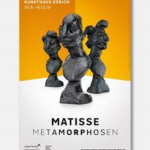Henri Matisse

The French artist Henri Matisse (1869-1954) was also a great sculptor. The exhibition examines his sculptural work through the prism of the creative process and transformation and focuses on the artistic method Matisse brought to bear in almost all his principal sculptures: starting out from a seemingly naturalistic approach, his figures progressed through increasing degrees of abstraction that culminated in radical stylization. As if by metamorphosis, his bronzes are transformed from a natural to an abstract form. There are parallels with this process in his paintings and drawings, and the exhibition explores the relationship between them for the first time. More than 70 works from all over the world, accompanied by reproductions of historical photographs, films and music, offer a vivid presentation of Matisseʼs artistic method. Various sources of his inspiration – nude photographs, originals from African art and Antiquity –complete the presentation.


